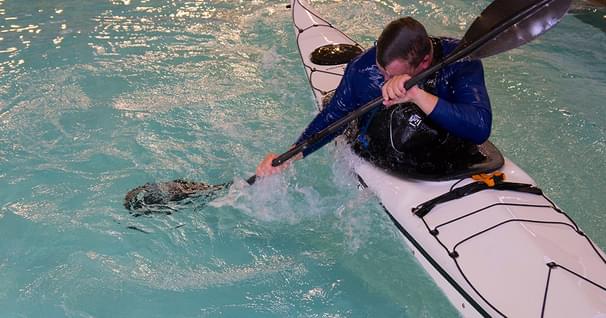The Forward Stroke
It propels us in a straight line. Although it may be the stroke we do 95% of the time to get around, it is also the stroke that most of us are the least proficient at. This little tune-up is borne out of influences of the BCU, ACA and Greg Barton, one of the best forward stroke artists ever. Before we get started on the actual stroke, lets get connected to the paddle in a healthier way.
Start with a loose hand grip...like you are holding your paddle with your thumbs and forefingers in an OK sign. This allows you to get good reach without cocking your wrists back and forth, reduces friction (no blisters), allows good blood flow (keeping your fingers warm) and helps your forearms to relax. Your hands should be about shoulder width apart. Ultimately, your arms just attach you to your paddle which you move with the larger muscle groups in your back, stomach and your butt. So, how do we do that?
Let's break down the stroke into the catch, propulsion and recovery phases. For the catch phase, sit up straight and get your arms fairly stretched out in front of you and wind your body up to the left so you get a really good forward plant with your right paddle blade. Your reach will be increased when you rotate your right shoulder forward...and every inch further forward you can reach is an inch further you can travel with this one stroke.
50 years of lightweight, maneuverable, high-performing kayaks.
Check out this interview with Tom Keane, Eddyline Kayaks Co-Owner, on their journey!
Now, during the propulsion phase you'll unwind your body by rotating your torso to the right, pulling the blade until it is even with your right hip (end, finito, stop pulling). Your paddle gently exits the water here for the recovery, putting you in position for your windup for your stroke on the left side. You'll find that by keeping your uphill hand pushing out about level with your shoulder, your paddle blade will be buried to the proper depth on the downhill side. This also protects your shoulder joint, so you can do this comfortably for a long time.
Key points:
- Keep fairly straight arms...it forces you to rotate your torso to move your paddle.
- Open your uphill hand as you push away (as if you are going to reach for your bow)...this helps encourage a relaxed hand grip and lets the paddle do the work.
- Stop propulsion phase as the paddle blade passes even with your hip....any further simply pulls the stern to the side pulling you off course. Oh, that's right, this stroke is supposed to propel us in a straight line!
A good forward stroke allows you to move ahead smoothly with a minimum of effort and stress on your joints. It also keeps a large share of your body in motion keeping your back and bottom from getting stiff. You can even practice the torso rotation with a broomstick in front of the TV, giving your neighbors yet another thing to talk about!
Michael Gray is director of Uncommon Adventures, specializing in kayak instruction and adventure tours since 1984. He has taught paddling technique in New Zealand, Belize, Honduras and all over North America. Uncommon Adventures can be found on the web at www.uncommonadv.com
Related Articles
By changing how you edge and balance your boat you can increase your stability and adaptability. Using…
Whether you were new to paddling in 2018 or you're an experienced paddler, you can never stop learning.…
Mention “pool session” and the first image that pops into most kayakers minds is a class in how to roll.…
Photo Credit: Darlene Patterson Many people who have paddled for years can't keep a canoe on a straight…




